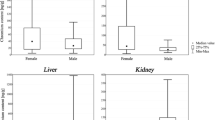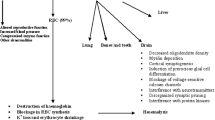Abstract
Lead levels in whole blood could be determined reliably up to a lower limit of 2 μg/100 ml blood, using a modified micromethod of the graphite tube furnace technique. Lead contents of various tissues were also determined by using the automated graphite tube furnace after wet ashing of the organs with nitric acid in autoclaves.
Animal experiments with mice showed no measurable increase in blood lead level after a single, 10- or 30-days oral administration of lead in doses of 10–1000 μg lead acetate/kg body weight/day. However, these doses led to a rise in tissue lead content. There was a clear dependence of tissue lead content on type of organ examined, lead dose and duration of lead exposure.
According to our experiments, the threshold dose which leads to a long-term increase in tissue lead content is assumed to be about 100 μg lead acetate/kg body weight/day, orally administered.
Similar content being viewed by others
References
Anderson A (1976) Interferences from sulpher in the determination of lead with the graphite furnace. Atom Absorp Newslett 15: 71–72
Bodenseewerk, Perkin-Elmer & Co GmbH Überlingen (1975) Beschreibung und Bedienungsanleitung Autoklav 3
Bruenger FW, Stevens W, Stover BJ (1973) The association of Pb210 with constituents of erythrocytes. Health Phys 25: 37
Chisolm JJ Jr (1978) Is lead poisoning still a problem? Clin Chem 23: 252–255
Chisholm JJ Jr, Barltrop D (1979) Recognition and management of children with increased lead absorption. Arch Dis Child 54: 249–262
Conrad ME, Barton JC (1978) Factors affecting the absorption and excretion of lead in the rat. Gastroenterology 74: 731–740
ECC (1975) Health protection directorate, Lucembourg. Biological sampling for monitoring population exposure to lead. Galway, Irland, July 7–8
Evenson MA, Pendergast DD (1974) Rapid ultramicro direct determination of erythrocyte lead concentration by atomic absorption spectrometry, with use of a graphite tube furnace. Clin Chem 20: 162–171
Fernandez FJ (1975) Micromethod for lead determination in whole blood by atomic absorption, with use of the graphite furnace. Clin Chem 21: 558–561
Fernandez FJ (1978) Automated microdetermination of lead in blood. Atom Absorp Newslett 17: 115–116
Garnys VP, Matousek JP (1975) Correction of spectral interference with determination of lead in blood by non-flame atomic absorption spectrometry. Clin Chem 21: 891–893
Garnys VP, Smythe LE (1975) Fundamental studies on improvement of precision and accuracy in flameless atomic absorption spectrometry using the graphite tube atomiser. Talanta 22: 881–887
Gorsuch TT (1970) The destruction of organic matter. Pergamon Press, New York, p 93
Hammond PB (1977) Exposure of humans to lead. Ann Rev Pharmacol Toxicol 17: 197–214
Hanna TL, Dietzler DN, Smith C, Gupta S, Zarkowsky HS (1976) Erythrocyte porphyrin analysis in the detection of lead poisoning in children. Evaluation of four methods. Clin Chem 22: 161–168
Knutti R, Balsiger C, Schlatter C (1977) Probleme der Metall-Spurenanalyse im ppb-Bereich in biologischem Material am Beispiel der Bestimmung von Blei im Blut mit Graphitrohr-Atomabsorptionsspektrometrie. Mitt Gebiete Lebensm Hyg 68: 78–85
Kotz L, Kaiser G, Tschöpel P, Tölg G (1972) Aufschluß biologischer Matrices für die Bestimmung sehr niedriger Spurenelementgehalte bei begrenzter Einwaage mit Salpetersäure unter Druck in einem Teflongefäß. Fresenius' Z Anal Chem 260: 207–209
Langmyhr FJ, Kjuus I (1978) Direct atomic absorption spectrometric determination of cadmium, lead and manganese in bone and lead in ivory. Anal Chim Acta 100: 139–144
Lauwerys R, Buchet JP, Roels H, Berlin A, Smeets J (1975) Intercomparison program of lead, mercury and cadmium analysis in blood, urine and aqueous solutions. Clin Chem 21: 551–557
Machatta G, Binder R (1973) Bestimmung von Blei, Thallium, Zink und Cadmiumspuren in biologischem Material mittels flammenloser Atomabsorption. Z Rechtsmed 73: 29–34
Maher CC, Roettgers DM, Conlon HJ (1979) Interlaboratory comparison of blood lead determination. Am Ind Hyg Assoc J 40: 230–237
Manning DC, Slavin W (1978) Determination of lead in a chloride matrix. Atom Absorp Newslett 17: 43–46
Nise G, Vesterberg O (1978) Blood lead determination by flameless atomic absorption spectroscopy. Clin Chem Acta 84: 129–136
Reigart JR, Whitlock NH (1976) Longitudinal observations of the relationship between free erythrocyte porphyrins and whole blood lead. Pediatrics 57: 54–59
Roschnick RK (1973) The determination of lead in foods by atomic absorption spectometry. Analyst 98: 596–604
Schlick E, Kretz FJ (1978) Die Wirkung von Blei in kleinen Dosen auf die erythrozytäre D-ALA-D und das RES der Maus. Inaugural-Dissertation, Fakultät für klinische Medizin, Mannheim
Schlick E, Friedberg KD (1980) The action of small doses of lead on erythrocyte d-aminolevulinic acid dehydratase in the mouse. Arch Toxicol 43: 213–220
Schrammel P (1973) Determination of eight metals in the international biological standard by flameless atomic absorption spectrometry. Anal Chim Acta 67: 69–77
Szadkowski D, Meier U, Lehner G (1979) Tierexperimentelle Untersuchungen zum toxikokinetischen Verhalten von Blei. Inn Med 6: 217–222
Therrel BL, Drosche JM, Dziuk TW (1978) Analysis for lead in undiluted blood by tantalum ribbon atomic absorption spectroscopy. Clin Chem 24: 1182–1185
Thompson KC, Wagstaff K, Wheatstone KC (1977) Method for the minimisation of matrix interferences in the determination of lead and cadmium in non-saline waters by atomic absorption spectrometry, using electrothermal atomisation. Analyst 102: 310–313
Volosin MT, Kubasik NP, Sine HE (1975) Use of the carbon rod atomiser for analysis of lead in blood: Three methods compared. Clin Chem 21: 1986–1987
Willes RF, Lok E, Truelove JF (1977) Retention and tissue distribution of Pb210 (NO3)2 administered orally to infant and adult monkeys. J Toxikol Environ Health 3: 395–406
Winneke G, Kasta J (1974) Neurotoxische und verhaltenstoxische Aspekte der Bleiwirkung in Lufthygiene und Silikoseforschung 1973. Gesellschaft zur Förderung der Lufthygiene und Silikoseforschung e. V., Düsseldorf (Hrsg). Essen, Girardet, p 91
Author information
Authors and Affiliations
Additional information
We are thankful to Prof. Dr. H. Rüssel, Hannover and Dr. M. Fleischer, Saarbrücken for helping in comparison studies.
We would also like to thank Mr. H. Dick and Miss. Ch. Hecker for the technical and laboratory assistance.
Rights and permissions
About this article
Cite this article
Schlick, E., Kamran, M.A. & Friedberg, K.D. Lead in blood and tissues of mice after administration of low lead doses. Arch Toxicol 46, 221–232 (1980). https://doi.org/10.1007/BF00310438
Received:
Issue Date:
DOI: https://doi.org/10.1007/BF00310438




